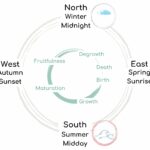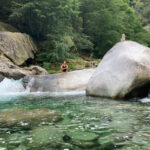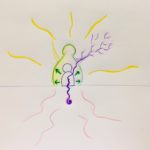What are some of the major life transitions you went through?
Do you remember how you felt when many things you thought to know, started crumbling into chaotic pieces losing the meaning they had until then? In such a moment your worldview and identity die. In that sense I may also have asked: how many times have you died?
Most of us have experienced several life transitions. From starting our first job, getting married, becoming sick, losing a beloved person… events like these lead us into an “unknown land” in which we are transformed.
Whether stepping into the unknown land is the equivalent of having a nightmare you cannot wake up from or a journey in which we experience pain, growth and aliveness depend on our attitude, understanding of the bigger picture and the social-cultural support we receive.
If we talk about a collective transformation towards a regenerative economy, culture and society – we have to acknowledge that the way we embark on this process makes a big difference in our ability to take action and live with it. We can ignore the environmental crisis we face until we have no more choice than to deal with its consequences or we can acknowledge that change is anyway happening and create room for collectively processing and growing with and through it. How we navigate the transformation makes a difference.
How can we welcome and navigate transformations?
A transition into a new life phase, as well as the collective transition into a society having a healthy relationship with the ecosystem it is part of, in its essence is a process of:
- dying,
- being in the space in between – where there is no way back and no clear way forward,
- and of being reborn into a new form.
What does that look like?
Let’s look at a familiar example. A radical transformation you may remember is the one from the teenage years – that’s a time when we question everything and everyone, we wonder who we are, experiment, and try out different ways to connect and belong. As a teenager, you know that you are not anymore a child – that identity is death, it is not anymore the midpoint you operate from – you don’t know who will you be as an adult and would really like to know it, and are stuck in this place in between, that feels messy, scary and is full of possibilities.
When a teenager is not embedded in a supportive social network, they may struggle through this transformative time, trying extreme activities also endangering them and/or feeling deeply lost and overwhelmed while not knowing who they are and to fit into society.
A community can hold the space for personal transformation
When a child living in a healthy eco-centred community becomes a teenager, the elders recognise the imminent transformation process. They support the teenager in making sense of what is happening, help them to let go of their past identity and encourage them to follow the inner spark leading to discovering their vocation, by presenting them with different challenges. The parents – are the first surface of projection, the ones binding the teenager to the past. They alone cannot fully support the diverse needs of the transformation.
How can we support transformations at an individual level in our individualistic technology-centred society?
On an individual level cyclical nature-inspired maps of transformations can guide the process of death and rebirth (I recommend the four shields by the School of Lost Borders & the ones from the author Bill Plotkin). Community-based rites can support the dissolution – to let go of the past, one’s identity and mental models – hold spaces to be in the “time in between” safely, and confirm the new shape, role and identity a person is ready to take in the community.
The Vision Quest or Vision Fast is an example of a modern rite supporting such transitions. Thanks to this pan-cultural 10-12 days long ceremony – during which participants fast in solitude for 3-4 days and nights in nature – a life transition can be marked and celebrated by embodying the different aspects belonging to the process. This allows us to not only understand and accept the process rationally but to also “own it” emotionally and physically.
How can we support transformations at a collective level in our individualistic technology-centred society?
On a collective level, the nature-based maps mentioned above can provide guidance. Additionally, I like to recommend the Dandelion Spiral, a framework developed by Joanna Macy and used by The Work that Reconnects Network. Based on the frame many group exercises have been developed to support people to connect to gratitude, honour pain, see with new eyes and go forth.
When spaces are offered for groups of people to connect holistically – including the mind, heart, body and land – to the transformation that is happening on an individual and collective level, people are empowered, despite the difficulties perceived in letting go of the past and future expectations, as well as in the discomfort of being in the unknown, accept the transition and open up to emergent possibilities. That is when unforeseeable options appear and manifest: when transformative innovation occurs.
Some food for thought:
- Which major life transitions have you experienced?
- Who did you tell about it? How was it honored and celebrated?
- Which traditions exist in your place and culture to mark such transitions?
- What would you have wished for yourself and what do you wish for people that will go through similar transitions?
If you like to share some thoughts about your experiences or wonder how you could mark past transitions that don’t feel fully complete, write to me by using the contact form.




